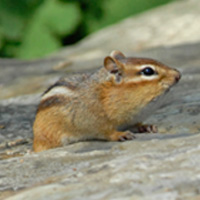General Characteristics
Chipmunks are small, ground-dwelling squirrel that is typically 5-6 inches long, with a tail 3-4 inches long. They have 2 tan and 5 blackish stripes lengthwise down their back and 2 tan and 2 brownish stripes on each side of their face. They do not completely hibernate throughout the winter, but will rely upon their cache of food stored throughout the summer and may sometimes be seen on warm, sunny days throughout the winter. They typically emerge from hibernation in early March.
Distribution
Chipmunks are found statewide in a variety of habitats. They are especially common in urban areas where bird feeders are found.
Reproduction
Chipmunks breed twice a year and will have 2-5 young in each litter, one born in late spring and one in late summer. Four to five young are born in April or May. Young will appear outside their den when they are only 4-6 weeks old and will start to find their own territory when they are just 6-8 weeks old.
Food Habits
Chipmunks eat a variety of foods, primarily grains, nuts, berries, seeds, mushrooms, insects, and even carrion. They regularly climb trees in the fall to find nuts, fruits, and seeds. They will also eat bird eggs and young birds when available. Chipmunks cache or store food in their dens by stuffing it into their cheeks, then transporting it to their den.
Prevention and Control
Place bird feeders at least 20 to 30 feet away from buildings. Place squirrel guards or other devices on poles used for bird feeders to prevent chipmunks from eating all of the bird seed.
Exclude chipmunks from buildings to prevent structural damage by using hardware cloth with ¼ inch mesh, caulking, or other materials to close openings around the foundation of your house, patio, deck, or shed.
Keep chipmunks from damaging flower beds by covering seeds and bulbs with ¼ inch hardware cloth and then covering the cloth with soil. The hardware cloth should extend at least 1 inch past the edge of the bulb or seed that you are trying to protect.
Cage traps can be used to capture chipmunks that are baited with peanut butter, sunflower seeds, raisins, or even cereal grains. Rat snap traps can also be used to catch chipmunks and should be placed next to the chipmunk’s pathway. Be sure to avoid killing songbirds in these snap traps by placing these traps under a small box (like a shoebox) with an opening that allows only chipmunks or mice to enter. You can also conceal these traps by leaning boards over them and setting small amounts of bait near the opening. You do not need a permit to trap a chipmunk, but you must have permission from a landowner or property manager to release one on their property.
Chipmunks can be captured or killed year-round without a permit or hunting or trapping license from the DNR, and there are no limits to the number that can be taken.
